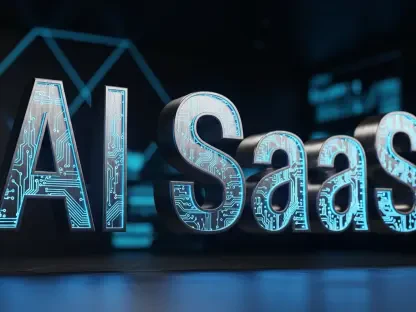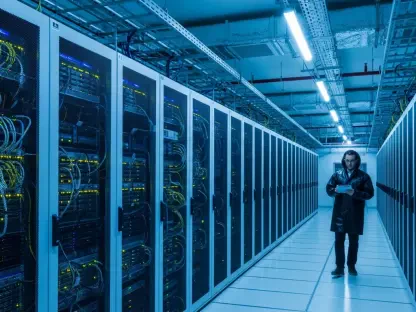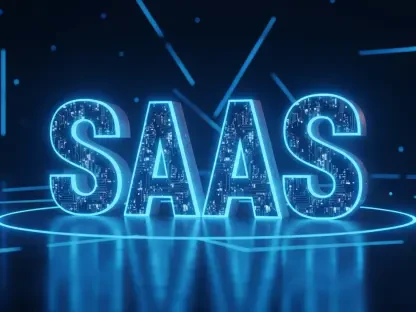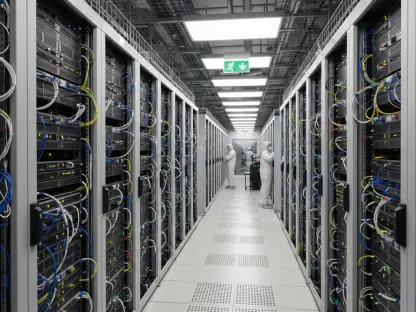Setting the Stage for Cybersecurity Challenges
In an era where businesses depend heavily on cloud-based solutions, the staggering statistic that over 90% of organizations use multiple SaaS (Software as a Service) applications reveals both an opportunity and a vulnerability. This widespread adoption has transformed operational efficiency, enabling seamless collaboration and scalability. However, it has also opened the door to sophisticated cyber threats, with data breaches and insider risks becoming more prevalent. The urgency to secure these environments is paramount, as a single breach can compromise sensitive information and erode trust. This pressing challenge sets the stage for exploring how innovative players like DoControl are stepping up to redefine SaaS security and harness AI for advanced threat detection.
The cybersecurity landscape today is marked by rapid evolution, driven by the sheer volume of data stored in cloud ecosystems. Organizations face not only external attacks but also internal vulnerabilities, such as misconfigurations and unauthorized access. As SaaS platforms like Google Drive and Slack become integral to daily operations, the complexity of managing security across disparate systems grows. This environment demands solutions that go beyond traditional measures, integrating cutting-edge technologies to anticipate and neutralize risks before they escalate.
The Growing Importance of SaaS Security and AI in Cybersecurity
The Current State of the Cybersecurity Landscape
The reliance on SaaS applications has become a cornerstone of modern business, streamlining processes from communication to data storage. With this dependency comes an expanded attack surface, as cybercriminals increasingly target cloud environments to exploit vulnerabilities. Data breaches, often resulting from weak access controls or phishing schemes, can lead to significant financial and reputational damage, underscoring the need for robust security frameworks.
Beyond external threats, insider risks pose a substantial challenge, whether through negligence or malicious intent. Employees with access to critical systems may inadvertently expose data, while rogue actors could intentionally leak information. The integration of AI into cybersecurity offers a promising avenue to address these issues, providing predictive insights and automating responses to mitigate threats in real time. This technological shift is no longer optional but essential for staying ahead of adversaries.
As threats evolve, so must the tools to combat them. The dynamic nature of cyber risks, fueled by advancements in hacking techniques, requires adaptive measures that can learn and respond quickly. AI’s ability to analyze vast datasets and identify patterns positions it as a game-changer in fortifying SaaS environments against both known and emerging dangers.
Key Players and Technological Influences
Within this competitive arena, several companies are making strides, but DoControl stands out for its specialized focus on SaaS security. Recognized as a leader in the industry, this organization has carved a niche by addressing the unique challenges of cloud-based applications. Its prominence is evident through consistent acknowledgment by industry experts and peers as a frontrunner in innovative cybersecurity solutions.
Technological advancements, particularly AI-driven threat detection, are reshaping how security is approached in the sector. Machine learning algorithms now enable systems to detect anomalies and predict potential breaches with unprecedented accuracy. This trend is complemented by the growing adoption of SaaS solutions, as businesses seek scalable and cost-effective tools, further driving the demand for integrated security platforms that can keep pace with rapid digital transformation.
Market dynamics also play a critical role, with increased cloud migration pushing organizations to prioritize security investments. The convergence of SaaS and AI technologies reflects a broader shift toward proactive defense mechanisms. Companies that can harness these innovations effectively, as DoControl has, are well-positioned to influence the direction of cybersecurity over the coming years.
DoControl’s Innovative Solutions in SaaS Security
A Unified Platform for Comprehensive Protection
DoControl has developed a unified platform that offers unparalleled visibility and control across a range of SaaS applications, including Microsoft SharePoint, Salesforce, and Box. This solution empowers security teams to monitor data flows and user activities in real time, ensuring that potential vulnerabilities are identified before they can be exploited. By centralizing oversight, the platform simplifies the management of complex SaaS ecosystems.
Key features such as contextual data loss prevention (DLP) stand out, enabling granular protection tailored to specific user behaviors and data types. Automated remediation workflows further enhance efficiency, allowing immediate action to contain threats without manual intervention. These capabilities address critical pain points, such as unauthorized data sharing, which often go unnoticed in fragmented security setups.
Additionally, the platform tackles issues like identity threat detection and response (ITDR), shadow apps, and configuration errors. By mapping out hidden applications and securing user identities, DoControl ensures a multi-layered defense strategy. This comprehensive approach not only mitigates risks but also builds a foundation for scalable security as organizations expand their SaaS footprint.
Industry Recognition and Market Impact
The industry has taken note of DoControl’s contributions, as evidenced by its dual honors at the Top InfoSec Innovator Awards this year for SaaS/Cloud Security and AI Threat Detection. These awards, presented by a respected publication in the cybersecurity field, highlight the company’s ability to innovate in a crowded market. The selection process, guided by seasoned professionals, underscores the significance of this achievement.
Endorsements from industry voices, such as editors at leading cybersecurity magazines, reinforce DoControl’s standing. Such recognition is not merely symbolic; it reflects a consensus on the tangible impact of their solutions in protecting organizations from escalating cyber risks. The accolades serve as a benchmark for excellence, setting a standard for others in the field.
This acknowledgment also signals DoControl’s broader influence on market trends. By addressing both SaaS security and AI-driven threat detection, the company is shaping how businesses approach cloud protection. Their success encourages a shift toward integrated platforms, pushing competitors to elevate their offerings in response to heightened expectations from enterprise clients.
Leveraging AI for Advanced Threat Detection and Response
DoControl’s adoption of AI-powered tools marks a significant leap in how threats are identified and managed within SaaS environments. Contextual monitoring, driven by machine learning, allows the platform to understand user behavior and flag deviations that might indicate a risk. This nuanced approach ensures that alerts are meaningful rather than overwhelming security teams with false positives.
Behavioral analytics further refine threat detection by establishing baselines for normal activity across applications. Real-time analysis, paired with automated data classification, enables swift categorization of sensitive information, ensuring it remains protected. End-to-end remediation workflows close the loop, addressing incidents from detection to resolution without delay, a critical factor in minimizing damage.
By leveraging AI, DoControl stays ahead of sophisticated cyber threats that traditional methods struggle to counter. This leadership in adapting intelligent technologies to SaaS security demonstrates a forward-thinking mindset. As threats grow more complex, their ability to anticipate and neutralize risks positions them as a trusted partner for organizations navigating the digital landscape.
Challenges in SaaS Security and DoControl’s Strategic Approach
Securing SaaS applications presents unique hurdles, including the risk of data exposure due to lax permissions or human error. With employees often using multiple tools, the potential for accidental leaks or deliberate misuse increases. These challenges are compounded by the sheer volume of data moving through cloud systems, making comprehensive oversight a daunting task.
Technological and operational complexities add another layer of difficulty. Diverse SaaS ecosystems, each with distinct configurations and access protocols, create gaps that attackers can exploit. Managing these environments requires not only technical expertise but also a strategy that aligns with business workflows to avoid disrupting productivity while maintaining security.
DoControl addresses these issues through proactive measures, such as fostering user engagement to promote secure practices. Their scalable solutions adapt to varying organizational needs, ensuring that security grows alongside SaaS adoption. By focusing on both prevention and rapid response, their strategic approach minimizes vulnerabilities and builds resilience against the multifaceted risks inherent in cloud-based operations.
The Future of SaaS Security and AI-Driven Cybersecurity
Looking ahead, emerging trends point to an even greater role for AI in preempting cyber threats within SaaS frameworks. Predictive analytics and automated threat hunting are expected to become standard, enabling systems to thwart attacks before they materialize. This evolution will likely redefine security protocols over the next few years, from this year to 2027, as adoption accelerates.
Potential disruptors, such as novel technologies and shifting threat landscapes, will continue to challenge existing paradigms. Quantum computing, for instance, could alter encryption standards, while attackers may leverage AI themselves to craft more elusive threats. Staying agile amid these changes will be crucial for companies aiming to maintain robust defenses in an unpredictable environment.
DoControl’s commitment to innovation positions it as a model for future growth in this space. By continuously refining their platform and anticipating SaaS security challenges, they demonstrate a readiness to adapt. Their focus on integrating advanced AI capabilities ensures that they remain at the forefront, offering a blueprint for how cybersecurity can evolve to meet tomorrow’s demands.
Reflecting on Achievements and Looking Ahead
Reflecting on the insights gathered, DoControl’s dual recognition at this year’s Top InfoSec Innovator Awards underscores their pivotal role in advancing SaaS security and AI-driven threat detection. Their unified platform provides a robust shield against the vulnerabilities of cloud environments, while their strategic use of AI sets a high bar for real-time threat management. This acknowledgment from industry peers validates their impact on shaping cybersecurity practices.
Moving forward, organizations should consider adopting integrated solutions like those pioneered by DoControl to address the growing complexity of SaaS risks. Investing in AI-enhanced tools offers a pathway to anticipate threats rather than merely react to them. Collaborative efforts between security providers and businesses will also be key to staying ahead of evolving challenges.
As the digital landscape continues to shift, the emphasis on scalable and adaptive security measures becomes increasingly critical. Exploring partnerships with innovators in the field could unlock new ways to safeguard sensitive data. Ultimately, the journey to secure cloud-centric operations demands ongoing vigilance and a willingness to embrace cutting-edge technologies for lasting protection.









